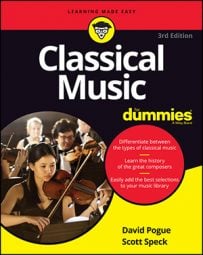One bit of weirdness strikes you the first time you go to a classical music concert, guaranteed: Nobody claps when the playing stops! “What the heck is wrong with this audience?” you think. “That was great playing!”
Why nobody claps
The crowd, having followed along in the program, knows that the piece isn’t over yet — only one movement, or section of a piece, has ended. So they wait. It’s pretty embarrassing to start cheering and applauding wildly, only to find out that the music’s still going and that 1,864 people are glaring at you.
Here are some general clues that the music is completely over:
The conductor puts down his hands and keeps them down. (If he doesn’t want you to clap, the conductor sometimes signals this fact by keeping his hands up and waiting patiently, or by turning around and looking directly into the eyes of the clappers, or by shouting “Not yet!”)
All the players on stage put down their instruments.
Everyone around you starts clapping.
The concert hall lights come up.
The players exit the stage, carrying their instruments.
The entire audience leaves the auditorium.
The cleaning crew comes in and begins to mop the stage.
Of course, you have more practical cues to tell you when the entire piece — including all its various sections — is totally over. For example, look at the program; it always tells you, right under the name of the piece you’re listening to, how many movements (sections) it has. (Most symphonies have four; most concertos have three.)
Now, you occasionally encounter a piece where a couple of movements are connected, or where the entire piece is played without pause, making it difficult to figure out where the next movement begins. In this case, the audience often begins clapping before you know that the piece is over. No big deal.
More on the insane “no-clap” policy
Actually, clapping between movements is a very hot topic in classical music circles nowadays. People don’t do it for two reasons: First, peer pressure. Second, the following accepted wisdom, which has been in place only for the last few decades:
A symphony (or concerto or suite) is conceived as a whole. The movements are often related to one another. They belong together, like sentences in a paragraph or chapters in a book. Clapping between them causes them to become disconnected in your mind. It makes you forget, by the end, what happened at the beginning.
Here’s why the accepted wisdom is bunk:
Audiences, not wanting to cough while the music is playing, save their bronchial attacks for the between-movement lulls and then start coughing en masse. From the orchestra’s point of view, this situation is much better than coughing while they’re playing, but the coughing nonetheless breaks up the flow of the music at least as much as clapping could.
Sometimes, the orchestra needs to tune up between movements. The sound of all the instruments fiddling with their pegs, valves, strings, mouthpieces, and lengths of tubing — in all keys at once — breaks up the flow again.
Most importantly, sometimes the first, second, or third movement of a piece is just so darned exciting that you want to clap. Take concertos, for example, that feature one soloist with the orchestra. Try finding a piece of music that ends as excitingly as the first movement of Tchaikovsky’s Violin Concerto or his Piano Concerto no. 1. Not clapping after these movements end would be unnatural, crazy, and downright wrong. They’re monumentally thrilling. You should stand up, yell and scream, throw cash, and prance around the auditorium in celebration.
But what happens instead? A scattering of coughs, and that’s all.
In the old days, when classical music was pop music, audiences regularly expressed their approval (or disapproval) of a performance of a piece of music while it was being played. Concerts were big, fun, healthy, rootin’-tootin’ free-for-alls — like stadium concerts today.
One reason the popularity of classical music has declined in the last century is the loss of fun in the concert-going experience. Sure, these pieces are classics; but the holiness bit has gone to an extreme. Beethoven never expected the audience to be silent before, during, and after his works were played. If he were alive today, he’d really think his hearing was going.
Fortunately, as orchestras try everything they can to woo lost audiences back into the concert halls, this stuffiness is slowly changing. The audience is now allowed to express itself more. Conductors, who for decades have been mute arm wavers on stage, are now sometimes permitted to speak from the podium.

